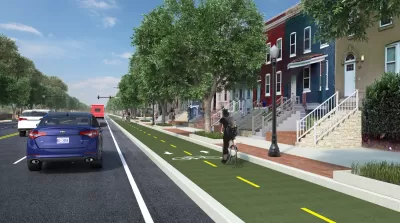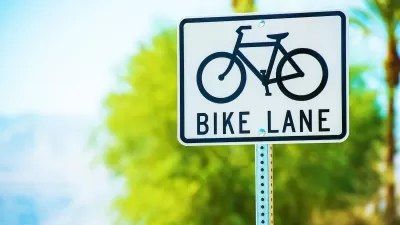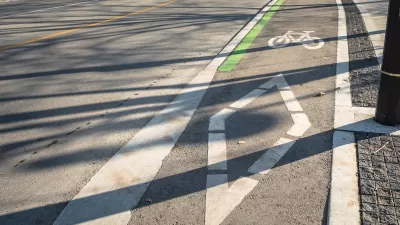The District of Columbia plans to install ten miles of protected bike lanes this year, among other improvements including additional bike parking and more e-bikes for the Capital Bikeshare fleet.

Washington, D.C. plans to add 10 miles of protected bike lanes to its current. 24-mile network, reports Luz Lazo. The District plans to install 30 total miles over the next three years. "Building bike infrastructure has been challenging for the District, where space is tight on many roadways and replacing parking or general traffic lanes has not been an easy sell. Some advocates have complained that the city has moved too slowly toward reaching its goals."
Lazo interviews George Branyan, manager of active transportation at DDOT, to understand the District's strategy for improving bike infrastructure and making biking more appealing to more residents. According to Branyan, during the pandemic, "There was a definite shift in patterns where we had not nearly as much of the commute-to-work peaks in the morning and the evening. But there were a lot of people who were biking at other times of day and on the weekends. A lot of people use the bike lanes just spread out over more time, and we also saw increases in trail use."
Branyan describes planned bike projects, including three miles of bike trails east of the Anacostia River, 2,500 new electric bikes in the District's bike share fleet, and 1,000 new bike racks across the District.
FULL STORY: D.C. wants to double its 24 miles of protected bike lanes. It plans to start with 10 miles this year.

Study: Maui’s Plan to Convert Vacation Rentals to Long-Term Housing Could Cause Nearly $1 Billion Economic Loss
The plan would reduce visitor accommodation by 25,% resulting in 1,900 jobs lost.

North Texas Transit Leaders Tout Benefits of TOD for Growing Region
At a summit focused on transit-oriented development, policymakers discussed how North Texas’ expanded light rail system can serve as a tool for economic growth.

Using Old Oil and Gas Wells for Green Energy Storage
Penn State researchers have found that repurposing abandoned oil and gas wells for geothermal-assisted compressed-air energy storage can boost efficiency, reduce environmental risks, and support clean energy and job transitions.

Private Donations Propel Early Restoration of Palisades Playground
Los Angeles has secured over $1.3 million in private funding to restore the Pacific Palisades playground months ahead of schedule, creating a modern, accessible space that supports community healing after recent wildfires.

From Blight to Benefit: Early Results From California’s Equitable Cleanup Program
The Equitable Community Revitalization Grant (ECRG) program is reshaping brownfield redevelopment by prioritizing projects in low-income and environmental justice communities, emphasizing equity, transparency, and community benefits.

Planting Relief: Tackling Las Vegas Heat One Tree at a Time
Nevada Plants, a Las Vegas-based nonprofit, is combating the city’s extreme urban heat by giving away trees to residents in underserved neighborhoods, promoting shade, sustainability, and community health.
Urban Design for Planners 1: Software Tools
This six-course series explores essential urban design concepts using open source software and equips planners with the tools they need to participate fully in the urban design process.
Planning for Universal Design
Learn the tools for implementing Universal Design in planning regulations.
Ascent Environmental
Borough of Carlisle
Institute for Housing and Urban Development Studies (IHS)
City of Grandview
Harvard GSD Executive Education
Toledo-Lucas County Plan Commissions
Salt Lake City
NYU Wagner Graduate School of Public Service




























